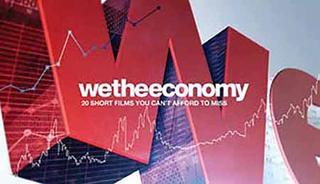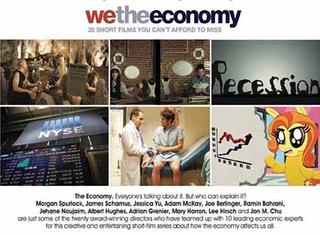Education Episodes Are Made For Multiplatform Release
Here’s an unlikely combination for the convergence era: a 21-episode video series called “We The Economy” about economic education; packaged for the short-attention- span generation; presented in multiple styles—comedies, musicals, animation, documentaries—and released simultaneously on broadcast, cable, online and mobile platforms, with a theatrical premiere thrown in. Add high-profile performers and directors, including Emmy-and Oscar-nominees/winners, plus funding from billionaire Paul Allen. And establish a business model that makes the shows free-on-demand to viewers while allowing limited advertising.

Gary Arlen
Given those parameters, the producers of “We The Economy” are ecstatic that the shows attracted 5.2 million views during the first three weeks of on-demand availability, and that every segment has generated at least 110,000 streaming sessions. That tally represents reports from only 23 of the 56 platforms carrying the series, so the backers are expecting even higher viewing levels of their mongrel series.
The initial “stick time,” or length of viewing, has averaged seven minutes initially, which indicates that viewers are generally watching at least one full episode, according to Cinelan, the New York branding/ marketing video production company that devised the series.
MULTIPLATFORM DISTRIBUTION
“Out-of-the-gate performance has been somewhat higher than we expected,” Karol Martesko-Fenster, Cinelan’s managing partner/cofounder, told TV Technology. He cited “big numbers” via LinkedIn and Yahoo! Connections, plus the creative ways in which distributors such as Netflix, CBS News, CNBC, Pivot TV, Hulu, Amazon Instant Video, YouTube and Vimeo are offering the presentations to their audiences. For example, Netflix calls all 21 episodes “Season One.”
Among the other distributors are Comcast’s Xfinity TV, Time Warner Cable, Cox, Verizon, BrightHouse, Mediacom, Suddenlink, Sony’s Crackle, Apple’s iTunes, AOL’s On Network and GooglePlay, plus specialty film/video firms such as Snag Films and multichannel networks such as Condé Nast’s The Scene.

Martesko-Fenster, a long-time video impresario behind the venture, worked with economists and top Hollywood production talent to create the series, which consists of standalone segments that are each five to eight minutes long. Nearly a dozen “advisors” (economists, historians, academics, journalists) are credited with supporting the productions. Watching all 21 productions takes a little more than two hours.
One significant factor of “We the Economy” is its benchmark status catering to the short-attention span of its target: young viewers. In addition, its education and public service status gives it a halo effect, which Cinelan is now exploiting to take the series to schools, libraries and other academic venues, as well as global markets and airline onboard programming as ancillary outlets for the video.
The mini-movies are intended to explain or present aspects of economics in an infotaining style. Episode titles include “GDP Smackdown,” “Fed Head,” “The Street” and “Taxation Nation,” with other segments explaining the role of government, globalization, financial inequality along with more basic topics, such as “What is Money?”

‘We The Economy’ poster Each episode was created by a different production team, albeit with occasional overlapping actors and talent. Among the prominent film- and videomakers taking part are Morgan Spurlock (who spearheaded the project via Cinelan, in which he has a stake), Catherine Hardwicke (director of “Twilight”), Adam McKay (“Anchorman”), James Schamus (“Crouching Tiger, Hidden Dragon”), Oscar-winning documentary-maker Barbara Kopple, and Adrian Grenier (actor and producer, best known for his role in HBO’s “Entourage” series).
The lineup also includes Chris Henchy (“The Campaign” and “Land of the Lost”), Jessica Yu (who has directed movies and TV episodes including “Scandal,” “Grey’s Anatomy” and “West Wing”) and Bob Balaban (a familiar character actor—“Grand Budapest Hotel,” “Girls,” “Alpha House,” “Seinfeld”—who also has a lengthy director/ producer resume).
“We immediately agreed to take the normal distribution model and smash it to pieces,” Spurlock told a Hollywood trade publication. “No windows, no fees, just get it to the public.” He said his major goal was to put “these films simultaneously in front of every American wherever they watch content.”
TAILOR-MADE FOR FOD
On the “We The Economy” website, Spurlock further explained the format, especially how differently it deals with a topic that would normally be very dry and straightforward. The episodes are bundled into five “chapters.”

Karol Martesko-Fenster
Martesko-Fenster points out that the series is not a pro-bono project; all the talent and advisors were paid via the Vulcan funding, although he declines to reveal the budget for the project. Distributors are not allowed to sell and insert commercials within any of the episodes, but some sites—such as Snag Films—are placing ads between segments.
Joe Cantwell, a Cinelan advisor and longtime cable TV programming executive, characterized the program format as “tailor-made” for the Free On Demand category.
“We worked closely with iN Demand to place, package and promote the series according to each cable company’s needs and opportunities,” Cantwell said, noting that iN Demand has “deep experience with independent film and FOD content.”
Social media has also played a big role in the series debut, Martesko-Fenster said. Many of the actors and directors used their own Twitter, Facebook, Pinterest and other accounts to tip off their fan bases about the show. Episodes with such talent-generated social media promotion had higher usage levels during the first few weeks, according to Martesko-Fenster.
Although Martesko-Fenster declines to disclose plans for future short-form ventures, the apparent success of “We The Economy” enhances the prospects for more multiplatform, short-length series with such high production values and high-minded intent.
It also might pave the way for more international options. Martesko-Fenster said that at the theatrical premiere—a free one-night-only showing at New York’s Lincoln Center and at other cities where policy- and decision-makers were invited to see the series’ highlights—Cinelan scored a few more deals. A German media operator at the New York screening followed up with an offer to carry the shows in Germany. Similar deals are underway for China and other countries, says Martesko-Fenster.
“We The Economy” could become a model for future content creation and presentation.
Gary Arlen is president of Arlen Communications LLC, a research and consulting firm. He can be reached atwww.ArlenCom.com.
Get the TV Tech Newsletter
The professional video industry's #1 source for news, trends and product and tech information. Sign up below.
Gary Arlen, a contributor to Broadcasting & Cable, NextTV and TV Tech, is known for his visionary insights into the convergence of media + telecom + content + technology. His perspectives on public/tech policy, marketing and audience measurement have added to the value of his research and analyses of emerging interactive and broadband services. Gary was founder/editor/publisher of Interactivity Report, TeleServices Report and other influential newsletters; he was the long-time “curmudgeon” columnist for Multichannel News as well as a regular contributor to AdMap, Washington Technology and Telecommunications Reports; Gary writes regularly about trends and media/marketing for the Consumer Technology Association's i3 magazine plus several blogs.

